Progeria is a rare genetic disorder that makes children seem like they are aging fast. Known by doctors as Hutchinson-Gilford Progeria Syndrome, it brings about aging symptoms quickly. These signs include not growing well, having distinct facial looks, losing hair, and unusual joints. It happens because of changes in a gene called LMNA. This gene makes a protein, lamin A, that helps keep a cell’s core strong. But the changed protein from the LMNA gene harms the cell core, causing early cell death in kids with Progeria.
Key Takeaways:
- Progeria is a rare genetic disorder that causes children to experience accelerated aging symptoms.
- Symptoms of Progeria include distinctive facial features, hair loss, joint abnormalities, and failure to thrive.
- The condition is caused by mutations in the LMNA gene, leading to the production of an abnormal version of the lamin A protein.
- Progeria is diagnosed based on clinical features, and genetic testing can confirm the presence of mutations in the LMNA gene.
- Although there is no cure for Progeria, stem cell therapy has shown promise in treating the disease by replenishing damaged cells and improving symptoms.
Symptoms of Progeria disease
Progeria is a disease that makes children age too soon, affecting their body’s growth. Kids with this condition don’t grow as fast as other children. They are also lighter than expected for their age.
These kids look different than most, with big, notable eyes and a nose that looks like a bird’s beak. They also have thin lips and a small chin. This unique look helps doctors recognize the disease early.
Kids with Progeria often lose their hair and their skin can appear older. They may also have joint problems and their body might not have much fat under their skin. Even with these physical challenges, their minds keep up just like anyone else.
They learn and move just like their friends. They can sit, stand, and walk within their normal growing years. It’s important to remember that inside, they are just like every other child.
Physical Symptoms of Progeria:
- Slow growth and low weight gain
- Prominent eyes
- Thin nose with a beaked tip
- Thin lips
- Small chin
- Hair loss
- Aged-looking skin
- Joint abnormalities
- Loss of subcutaneous fat
Causes and diagnosis of Progeria disease
Progeria is a rare genetic issue known as Hutchinson-Gilford Progeria Syndrome. It happens because of changes in the LMNA gene. This gene is vital for making the lamin A protein. This protein helps keep the cell’s nucleus working right.
Mutations in the LMNA gene make a strange form of the lamin A protein. This protein makes the nucleus shaky and causes it harm bit by bit.
We are still learning how these changes cause Progeria’s early aging signs. But, it seems the odd lamin A protein messes up key cell activities. This leads to faster aging in people with Progeria.
Doctors often spot Progeria by looking at the visible signs. They look for slow growth, small weight gain, and a unique face. Hair loss and joint issues are also common.
Confirming Progeria needs genetic tests. These tests check for LMNA gene mutations. They also rule out other diseases, ensuring a clear diagnosis.
Stem cell therapy for Progeria disease
Stem cell therapy is a hopeful treatment for Progeria, a rare disorder that makes people age quickly. It works by replacing damaged cells. This might slow down the disease and make patients feel better.
Scientists are looking into different types of stem cells. They are studying cells from umbilical cord blood and mesenchymal stem cells. Tests on animals and early human trials have been positive, showing that symptoms of Progeria can get better.
But, we still need more research to fully understand how stem cell therapy can help with Progeria. Right now, it’s a new and hopeful way to deal with this tough disease.

